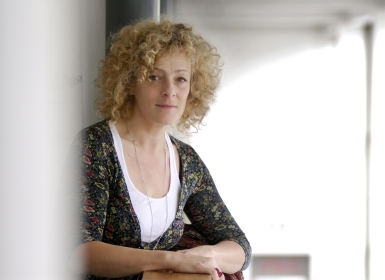
Biography
Teresa Moure is one of Galicia’s most accomplished writers. She is the author of five novels, the most famous of which is Black Nightshade, which received numerous accolades when it was first published, including the Xerais Prize for best novel and the Spanish Critics’ Prize for Galician fiction. She writes essays and theatre. Two essays, Another Language Is Possible and We Re-Queer a New World, received the Ramón Piñeiro Prize for best essay, while A Spring for Aldara won the Rafael Dieste Prize for best play. She has a doctorate in general linguistics and teaches in the faculties of philosophy and philology at Santiago de Compostela University.

Synopsis
The novel Black Nightshade (448 pages) is divided into four parts. The first part deals with Christina of Sweden, who became queen in 1633 at the age of six, on the death of her father Gustavus Adolphus during the Thirty Years’ War. She is famous for her conversion to Catholicism and removal to Rome, as well as for her patronage of the arts. The year is 1650, when Christina is still in Sweden, and we are introduced to the queen watching the river flow under one of the bridges of the old town in Stockholm, the island Stadsholmen. She wishes to devote herself to writing and indeed she is known to have been prodigious in her studies and knowledge of languages. In the novel, she has fallen in love with the memory of René Descartes, the French philosopher who visited the queen in 1649, following a correspondence between the two about hate and love. It was so cold in her castle that Descartes died there, having contracted pneumonia, in February 1650, shortly before the narrative opens.
Sample
This spring Stockholm seems unable to awaken from its winter lethargy. No birds have appeared yet, let alone flowers or butterflies, and the trees are still bare. You could even say the days are finding it difficult to grow longer after such a harsh winter as befell these blessed septentrional lands. Night is falling in Stortorget Square at the heart of the city. Even though it’s not past five in the afternoon, the yellow ochre colour of the whole district is losing its intensity and, in a few minutes, will be as pale as the waters flowing under the bridges, as grey as the waters that have just passed, as cold as the waters that right now are rushing towards the sea and in a moment will have merged with it. In a scene comprising such a withered landscape, with the cold air beating against the faces of passers-by, there is no way for thoughts to be anything other than gloomy. ‘We will never see the waters of this same river go by again.’ For Stortorget is a square between bridges and, on top of that, a sad square linked to life’s violence. Even though there’s no monument to record such an event, in another time Stortorget was the scene of a crime, which the population of Stockholm termed a ‘bloodbath’. In November 1520 the Danish king, Christian II, laid siege to the Swedish regent, Sten Sture the Younger, forcing him to capitulate and the Swedes to accept him as king. He promised them an amnesty and organized a magnificent banquet lasting three days in Tre Kronor castle. Having laughed and drunk, danced, sighed, toasted, sworn, having loved, dozed, drunk and feasted again, embraced, in short having enjoyed the good fortune of being alive, on the third day, as the festivities were drawing to a close, all the participants were arrested, accused of heresy. The following morning, more than eighty citizens, mostly nobles, were beheaded in this square, forever afterwards a square of pain and wounded pride. And yet today no blood flows down Stockholm’s canals, even though the incident can still be felt in the suspicion with which Swedes view outsiders. ‘We will never bathe in these same waters because the crossing already took place.’ These thoughts are not in the landscape, they originate from a human head casting a long shadow over the waters. No, in truth it is the whole figure, tall and slim, casting that elongated silhouette, the head itself is only a small part of this Chinese shadow, the least representative part perhaps because, the way the light is positioned at the moment, it is the lower section of the body that is emphasized and enlarged by dusk’s image. The human figure rests its hands on the parapet of one of the bridges, it doesn’t matter right now which one. The hands, which are thin, with elongated fingers, cannot be seen since they are wrapped in gloves. Without a clue from the hands, it is difficult to detect whether this is a man or a woman. The figure is wearing thick, ample clothes, which are rich and well cut, though not ostentatious. There are no frills or flounces on the lower edge of its costume to say this is a woman; nor is there a moustache or beard, breeches over boots, a feathered hat, to say this is a man. They could be young, not old, nor a boy or girl, nor a face of a different skin colour, from another country. The person leaning on the bridge, watching the waters, thinks, ‘Why is it we never realize the waters are passing until we see them singing on stones a step below the level where we find ourselves unable to grasp them?’ With such thoughts, it could be said this is a man, since the head of a woman is known to be more suitable for adornments than thoughts, especially thoughts as serious and deep as these. The human figure leaning on the parapet of the bridge is a sad person. Or, if you prefer, a person, who is sad. That is all that can be said of them. Apart from the fact they are wearing a black, woollen cloak down to their feet with a hood pulled over their head. Just like a friar. And yet anyone observing this figure will know it can’t be a friar. The clothes are not reminiscent of poverty, the look is far too rebellious to countenance obedience and… well, about chastity it is better to keep quiet in times like these when there are so many lechers leading exemplary lives… and chaste people being seen to. In any case, these lips, the lips of this human figure leaning on the parapet of the bridge in Stortorget, are extremely arrogant and hardly seem made to be eaten by worms before they’ve been a storm, nest, cave, before they’ve been sought and received. Apart from this, the face is balanced, not exactly beautiful or ugly, any adjective would have to be applied without excess, pure containment, high cheekbones and a protruding nose. The eyes cannot be judged since the hooded cloak, while not covering them directly, prevents them from being clearly seen, lending them a mysterious appearance. The human figure, alone like this, on the bridge, could be that of a Knight Templar recently arrived from Jerusalem in possession of the most treasured of secrets. It could also be that of a defendant recently escaped from prison. Or – why not? – that of an artist seeking inspiration in these waters flowing and chasing each other without ever being caught. The human figure on the bridge could belong to many, different characters and it is precisely this resistance to being labelled that would annoy an onlooker. Because if someone sees, for example, a young woman with two children clinging to her skirt, then they know this is a mother hurrying across the square to reach the safety of her home before it grows cold. But a figure like this one, on view today in Stortorget, is indefinable, independent, and that is what makes it troublesome. The figure, as if feeling shunned by passers-by, who are few and far between at this hour, turns around and starts walking. Its movements lend a certain distinction to its bearing. This elegant, stylized figure is not going to leave Stadsholmen, the largest island in Gamla Stan, and, having wandered a little down its old alleyways, suddenly, as if impelled by a spring, turns back on itself and marches confidently in the direction of Tre Kronor castle, home at the time to the Swedish monarchs. For the figure watching the sad flow of the waters is not a man, but a woman; is not old, but young; isn’t just another human figure, but the real Queen of Sweden. What is she doing here alone? At such an hour? Is she crazy perhaps?… She is. Her name is Christina.

